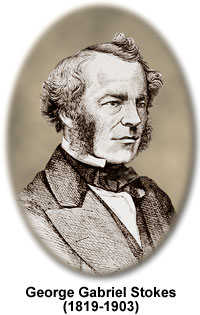George Gabriel Stokes
(1819-1903)

Born in Ireland on August 13, 1819, George Stokes was the youngest of six children. His father, a rector, directed his early education before sending him to a school in Dublin. Stokes attended Bristol College in England, followed by Pembroke College at Cambridge University, where he studied mathematics. He graduated in 1841 and was bestowed with many honors, including a fellowship that enabled him to remain at Cambridge. In 1849, Stokes was appointed Lucasian Professor of Mathematics and spent the rest of his life working at the prestigious school.
Throughout his career, Stokes emphasized the importance of experimentation and problem solving, rather than focusing solely on pure mathematics. His practical approach served him well and Stokes made important advances in several fields, most notably hydrodynamics and optics. An advocate of the wave theory of light, Stokes was one of the prominent nineteenth century scientists that believed in the concept of an ether permeating space, which he supposed was necessary for light waves to travel. Though the existence of an ether was later disproved, Stokes' efforts in the area helped pioneer the science of geodesy, the study of the Earth and its gravitational field.
In hydrodynamics, Stokes investigated a number of phenomena. Working in conjunction with Claude Navier, he developed a series of equations, known as the Navier-Stokes equations, which described the motion of viscous fluids. In 1850, Stokes made another important contribution to the field when he published a treatise in which he mathematically described the fall of an object through a liquid. Based on his equations and the work of others in the field, Stokes was able to explain the formation of clouds in the atmosphere.
An interest in light and its propagation led to Stokes' many experiments in optics. In 1849, he developed instruments and a method for measuring astigmatism in the eye, and by 1851 had invented a device that could be used to analyze polarized light. It was not until 1852, however, that Stokes carried out what was perhaps his most important optical research. The following is an excerpt of his influential findings, which were read to the Royal Society of London on May 27, 1852:
The following researches originated in a consideration of the very remarkable phenomenon discovered by Sir John Herschel in a solution of sulphate of quinine, and described by him in two papers printed in the Philosophical Transactions for 1845, entitled "On a Case of the Superficial Colour presented by a Homogeneous Liquid internally colourless," and "On the Epipolic Dispersion of Light." The solution of quinine, though it appears to be perfectly transparent and colourless, like water, when viewed by transmitted light, exhibits nevertheless in certain aspects, and under certain incidences of the light, a beautiful celestial blue color. It appears from the experiments of Sir John Herschel that the blue colour comes only from a stratum of fluid of small but finite thickness adjacent to the surface by which the light enters. After passing through this stratum, the incident light, though not sensibly enfeebled nor colored, has lost the power of producing the same effect, and therefore may be considered as in some way or other qualitatively different from the original light.
The noteworthy phenomenon observed by Stokes in quinine was that of fluorescence. Though Herschel had noted the occurrence previously, it was Stokes who revealed several important characteristics of the fluorophore. Most importantly, Stokes understood that the celestial blue color was exhibited only near the surface where the light entered the relatively concentrated quinine solution because the ultraviolet radiation of the sun, or other light source, was completely absorbed by only a shallow layer of the substance. As he pointed out, the light was "qualitatively different" after passing beyond this layer, or, more specifically, the ultraviolet was lacking in the remaining radiation. These findings enabled Stokes to formulate what has come to be known as Stokes Law, which holds that the wavelength of emitted fluorescent light is always greater than the wavelength of the exciting light. Closely associated to the law and frequently utilized for quantification purposes by scientists is Stokes shift, a measurement of the difference in wavelength or frequency between absorbed and emitted quanta.
Stokes' early research in fluorescence served as the basis for much of his future work in optics. For example, he used fluorescence for spectral analysis of ultraviolet radiation and eventually suggested that Fraunhofer lines were electronic transitions of elements that absorbed light of certain wavelengths from the sun's crust. However, during the second half of his career, Stokes expended an increasing amount of time carrying out administrative roles in various academic and political bodies, leaving him with less time to perform original research. Elected to the Royal Society in 1851, Stokes became its secretary in 1854, and remained in the position until he was elected its president thirty years later. He also served as president of the Cambridge Philosophical Society for six years and acted as a member of Parliament from 1887-1891. For his many scientific contributions, Stokes received a number of honors before his death in 1903, including the Rumford Medal in 1852, the Copley Medal in 1893, and a knighthood in 1889.
BACK TO FLUORESCENCE INTRODUCTION
